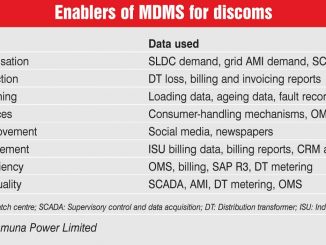
Power quality refers to both the extent of deviation or distortion in pure supply waveform and continuity in supply. Any significant deviation in the magnitude, frequency, waveform or symmetry of line voltages is a potential power quality problem. Poor power quality not only causes performance degradation and premature failure of electrical equipment but also results in increased system losses and financial losses. Although various electricity regulatory commissions’ (ERCs) regulations, such as supply/grid code and standards of performance (SoP), cover parameters pertaining to power quality, these are not uniform across states and do not cover all aspects related to power quality standards and its monitoring mechanism.
The “Report on Power Quality of Electricity Supply to the Consumers”, released recently by a sub-group on power quality (a part of the Working Group on Power Quality headed by the chairperson of the Forum of Regulators [FoR]), takes a comprehensive view of tackling these issues. The report lays emphasis on the need for regulations for power quality, the standards and limits to be followed, the incentive/disincentive mechanism and the procedure for monitoring, management and control of power quality. The sub-group has also suggested a draft model regulation on power quality.
Power Line presents the key highlights of the FoR report….
Impact of poor power quality
The losses due to poor power quality are economic as well as technical in nature. Poor quality of power leads to premature failure and reduced/degraded performance of equipment as well as increased system losses. According to a study conducted by the Manufacturers’ Association of Information Technology (MAIT) in 2009, Indian industries lost $9.6 billion due to power quality issues, which could have been averted by spending less than 10 per cent of the cost of losses. Another study performed by Wartsila India in 2009 estimated that in India, industries are spending close to Rs 300 billion annually on power back-up solutions, gensets and inverters. In 2012, the Federation of Indian Chambers of Commerce stated in a report that due to poor power factor, transmission capacity gets reduced and an estimated loss of Rs 54 billion is incurred annually owing to unserved energy. This energy could otherwise be served to users, if the average power factor had been 0.9.
Existing standard and regulation
The grid code, supply code and SoP established by various state electricity regulatory commissions (SERCs) do mandate the quality of power to be maintained; however, power quality parameters other than frequency and voltage interruptions are not given due attention. Besides, these regulations do not specify a monitoring mechanism for the quality of power. There is also a lot of variation in power quality parameters specified by different SERCs.
Globally, power quality standards and/or regulations are specified by institutes such as the Institute of Electrical and Electronics Engineers and the International Electrotechnical Commission. These regulations cover not only discoms but also individual consumers. In Europe, a discom’s performance is measured by supply continuity, voltage monitoring (voltage variations, flicker, unbalance, harmonics and mains signalling voltage) and reliability indices (Customer Average Interruption Duration Index [CAIDI] and System Average Interruption Frequency Index [SAIFI], etc.).
 Key recommendations
Key recommendations
Since the state regulators have not specified the mechanisms for monitoring, management and control of power quality parameters, the key recommendation of the sub-group is the adoption of power quality regulation by the states based on the model regulations. The model regulations on power quality proposed by the group include power quality indices, roles and responsibilities of various entities, the standards/limits to be followed, the incentive/disincentive mechanism to be deployed and the procedure for monitoring, management and control of all aspects of power quality. On the key power quality parameter front, the report notes that harmonic distortion, voltage variation and flicker, voltage unbalance, voltage sags/swells, and short and long supply interruptions are important.
With regard to the monitoring of power quality parameters at the transmission and sub-transmission levels, the report notes that it is the responsibility of the state transcos and the central transmission utility to maintain the quality of power as per the limits specified in the ERC regulations. However, there is lack of strict monitoring and implementation of these quality parameters by the regulators. Therefore, the report recommends that for maintaining power quality at the transmission and sub-transmission levels, the regulators should introduce appropriate reporting and incentive/disincentive mechanisms in their grid/supply codes or standards of performance regulations.
One of the crucial aspects of maintaining power quality is undertaking power quality monitoring at suitable locations. Since power quality measurements at all locations will entail huge investments, the report recommends that this should be implemented phase-wise. Power quality meters may be installed at select representative locations based on voltage level, type of consumers and significance of power quality. Besides this, power quality meters may be installed at the consumer-end in all areas prone to power quality disturbances or harmonic generation as well as other grid-connected entities such as distributed generation sources connected at a voltage level of 33 kV or below, electric vehicle charging stations and electricity prosumers. With regard to reporting of compliance, the report suggests that the information on various power quality parameters extracted from power quality meters should be reported in a standard format at regular intervals to the regulators.
With regard to the incentive/disincentive for power quality, the report recommends introducing tariff-based incentive/disincentive mechanisms for entities that cause distortion in power supply to consumers. Ideally, the level of incentive (being the penalty or reward) should be based on the costs that customers incur as a result of quality not being perfect as per the standards. Apart from this, the group recommends that the incentive/disincentive mechanism may be implemented in a phased manner over a period of two to three years following the issue of power quality regulations by the states. Another recommendation of the power quality sub-group pertains to maintaining power quality with the increasing use of smart grid applications. The group notes that a smart grid entailing two-way energy flows, connecting large and small, centralised and dispersed power sources poses challenges in measuring and monitoring power quality. Therefore, power quality may be integrated with the smart grid application through the adoption of appropriate technologies. Apart from this, the report suggests maintaining a more elaborative power quality database with detailed characterisation of loads. These databases would be used for formulating equipment specifications and identifying equipment that is most susceptible to power quality variations. Meanwhile, with regard to power quality audits, the report suggests that the regulatory framework should introduce a compliance audit of power quality parameters by an independent agency.
To conclude, with the large-scale integration of renewable energy into the grid and the adoption of electric vehicles, strict implementation of power quality standards is of paramount importance. However, since the power quality monitoring mechanism and the installation of devices for maintaining power quality entail huge investments, it is necessary to ensure that the power quality regulations keep in view the needs and requirements of the power sector in the state.
Priyanka Kwatra



